Big Bird Attacks in Nova Scotia
Posted by: Loren Coleman on August 6th, 2008
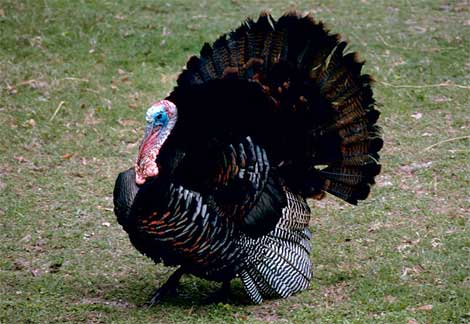
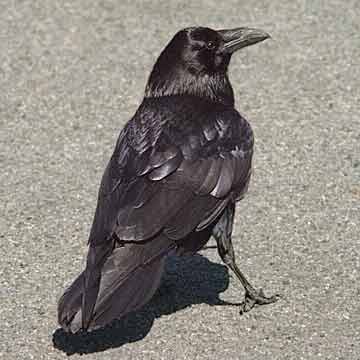
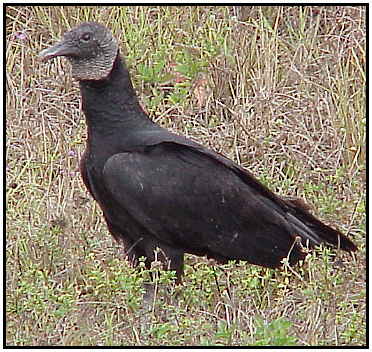
Are these the leading suspects? What kind of new winged attack is coming through a ground assault?
Reporter Beverley Ware of the Chronicle Herald in Nova Scotia writes of “‘Damn big bird’ giving some South Shore folks a fright ~ Enormous winged creature rushes, swoops at Crousetown residents,” for Wednesday, August 6, 2008.
Myles Rafuse carries a big stick on his daily walks after a “damn big bird” came at him during a recent stroll after church.
“I had quite an experience with it, I tell you,” said the Crousetown resident who turns 80 in a couple of weeks.
In fact, he wasn’t the only one to have a close encounter with the jet black bird.
“It was enormous really,” said Goldie Stewart, who said the bird barely missed her scalp as it swooped down at her while she was hanging out laundry.
“Maybe it was after my white hair,” chuckled the 73-year-old.
Mr. Rafuse was the first to have a close encounter with the gargantuan bird about a month ago. He was walking on a dirt road near his home southwest of Bridgewater after church on a Sunday.
“I was going along and it got kind of warm so I took my jacket off and carried it over my arm.”
Then he heard something in the woods along the side of the road. “This huge bird come at me on the road and made a rush at me.”
He said it was black as coal and stood “at least two feet high and it was wide. . . . The only thing that saved me from not getting tangled up was I kept hitting it with my jacket.” He said he ran backwards because he was afraid to turn his back on the bird.
He said the bird never flew, it just ran at him from the side of the road making a “howling like” noise with its wings partially out from its body. Then it suddenly turned and ran back into the woods.
“The damn thing could move quite swiftly,” but Mr. Rafuse said in that moment he moved pretty quickly, too. “It was kind of scary for a while.”
He hasn’t been up that road since and now carries a 1.5-metre-long stick with him on his daily walks.
About a week after that happened, Mrs. Stewart said she was in her driveway hanging out laundry when a massive black bird swooped down so close she felt the rush of the air from its wings on top of her head.
“If he would have put his claws down he would have struck the top of my head. I just stopped, it scared me so.”
It made a crying-like sound, she said. “It was weird.”
Initial reports were that it could have been a raven, a cormorant or a northern goshawk. Randy Milton is acting director of wildlife for the provincial Department of Natural Resources. He said it sounds too big to be a raven, cormorants do not go to inland wooded areas and a goshawk is grey.
Given its size and the fact the bird ran at him, Mr. Milton said it could be a turkey. “People have released turkeys in the province, not legally.”
They are not true wild turkeys, but a variant of a domestic turkey. “That is the only thing I could possibly think of that size,” Mr. Milton said.
A goshawk has more stealth and would attack from the rear, and neither a raven nor a cormorant would come running at someone from the ground.
“Turkeys can run quite fast,” and Mr. Milton said they can fly and do roost in trees.
For his part, Mr. Rafuse said the behemoth black bird hasn’t been spotted since Mrs. Stewart stood in her driveway and watched it fly off over a brook. But he hasn’t been back to that road since. “I don’t really want to unless I know it’s gone.”
Crousetown is a small rural community about 15 kilometres south of Bridgewater.

Osceola or Florida Turkey – Meleagris gallopavo osceola

Domestic turkey – Meleagris gallopavo
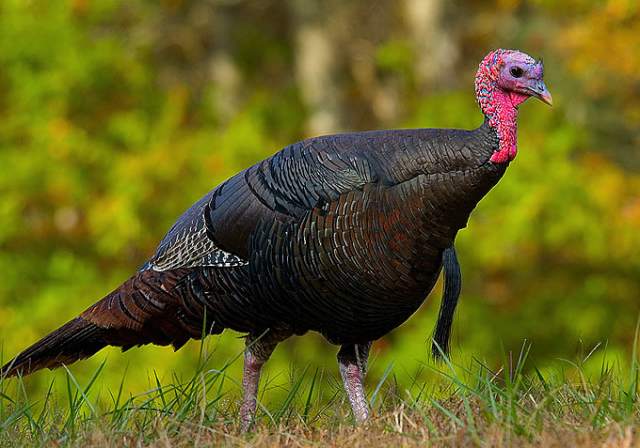
Eastern Wild Turkey – Meleagris gallopavo silvestris
The ground-based attacks certainly do suggest a turkey of some kind in this newest “Bridgewater Triangle.” Maine has “wild turkeys,” and it would seem reasonable that Nova Scotia might have some too.
Found that there are records of turkeys in Nova Scotia (mounted specimens below):
Description: 2 Wild Turkeys from Canada; Case 11 of Birds Mounted by Thomas J Egan for the Paris Exhibition ?
Subject: Animals; Birds; Taxidermy; Egan, T.J.
Coverage: (Geographic) Canada; Nova Scotia; Halifax ?
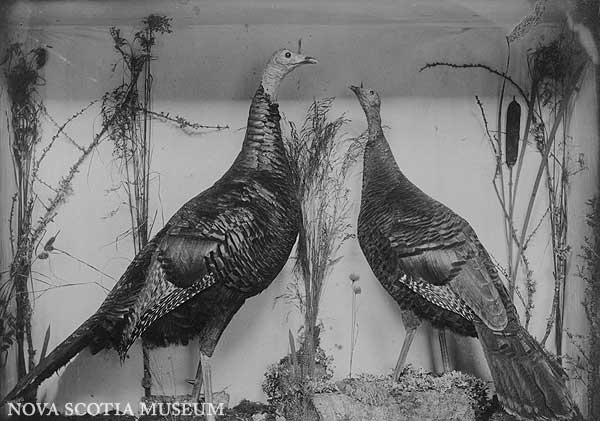
Another candidate: The Black Vulture (Coragyps atratus) – below – has four records in Nova Scotia. One killed at Pugwash, Cumberland County, on 12 January 1896 was sent to taxidermist T.J. Egan, in Halifax where it was examined by Piers (1897). Another killed at Owl’s Head, Halifax County, on 1 December 1918 was sent to taxidermist L.A. Purcell, in Dartmouth (Piers’ notes). The third was seen at Linacy, Pictou County, on 22 July 1936 by Alban Brown, who became familiar with this species and the following one when he lived in Florida before coming to Nova Scotia. The fourth was well studied by Betty June and Sidney Smith at Cape Sable one autumn in the early sixties.

How about a raven?

And less likely, a goshawk:
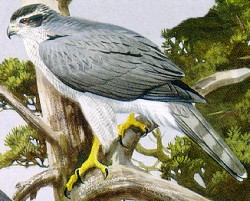
Thanks to Frank W. Norwood for forwarding this initial story.
Some turkey images from Coquina Daily.
About Loren Coleman
Loren Coleman is one of the world’s leading cryptozoologists, some say “the” leading living cryptozoologist. Certainly, he is acknowledged as the current living American researcher and writer who has most popularized cryptozoology in the late 20th and early 21st centuries.
Starting his fieldwork and investigations in 1960, after traveling and trekking extensively in pursuit of cryptozoological mysteries, Coleman began writing to share his experiences in 1969. An honorary member of Ivan T. Sanderson’s Society for the Investigation of the Unexplained in the 1970s, Coleman has been bestowed with similar honorary memberships of the North Idaho College Cryptozoology Club in 1983, and in subsequent years, that of the British Columbia Scientific Cryptozoology Club, CryptoSafari International, and other international organizations. He was also a Life Member and Benefactor of the International Society of Cryptozoology (now-defunct).
Loren Coleman’s daily blog, as a member of the Cryptomundo Team, served as an ongoing avenue of communication for the ever-growing body of cryptozoo news from 2005 through 2013. He returned as an infrequent contributor beginning Halloween week of 2015.
Coleman is the founder in 2003, and current director of the International Cryptozoology Museum in Portland, Maine.










Considering the age of the victims…. possibly just vultures who were a bit early for dinner????
Given thier description of a crying sound I would say it is most definatly a raptor of some type, and while it’s true that a Goshawk probably wont attack from the ground. If you happen to approach one while he’s on the ground…. they WILL stand thier ground, with wings spread and mouth wide open looking up and “screaming” at you…. I learned this much as a kid, we used to play baseball in a field not far from my house and about once or twice every summer for a couple years, a group of Goshawks would fly in to roost…. while flying in they WOULD sweep right over our heads(as if to intimidate us), and on the ground if we approached one for a closer look, it was VERY much like these folks described, and was actually a pretty scarry sight….. they put on a pretty convincing show!
I’d say Goshawks would be a pretty good guess, or maybe even my first guess… Vultures
Could this have been a crow? Over here in Japan, the crows not only get surprisingly large, they are also extremely bold and aggressive. They have been known to attack large dogs and cats won’t have anything to do with them. I once saw the horrible sight of a couple of crows eating a kitten that was still half alive. People aren’t exempt either, and the crows can be pretty scary when harassing people for food. They have very little fear of people and can be very intimidating to someone not expecting it. Some parks even have signs warning of the danger of being attacked by crows.
Contrary to what the article says about ravens, crows WILL run at people and I have seen it on occasion. They really are quite bold. And I must reiterate, they can be surprisingly large. I can easily see someone being taken aback and describing one as this size.
Some other things remind me of crows. The “howling sound”, for instance. Crows can make some incredibly odd and very loud sounds that I think could very easily be described as this. Also, the “running” described. Crows often hop around to where they want to go without bothering to take flight. I’ve seen them just hop around and absolutely dominate a park. The ones in Japan especially do this often.
Also, crows are jet black.
Turkeys are a good candidate, but is a large, aggressive crow a possibility? I believe so.
Another thing that points to a crow is the way it is described as holding its wings partially out from its body. When crows are trying to be intimidating, that is exactly what they do. Also, crows will swoop down on people whereas turkeys don’t. A vulture could be a candidate, but for reasons I have described here, a crow or raven (Whatever you like to call them, they are both actually the same thing, in the family of birds, Corvidae) is a likely culprit in my opinion.
heheheh, Crow was gonna be my 3rd guess, crows can get pretty bold!
A large Raven certainly strikes me as a possibility.
I’d favour cormorant: fits size wise, has a similiar neck to the afore-suggested Turkey, and does display swooping flight. (though as detailed they aren’t renound for their running or stealth on the ground)
The only thing that throws me a little is the account making reference to “claws”, something far more prevelent in the raptors than other species of birds.
My top three would be
Cormorant
Goshawk
another hawk species
SORRY
Raven was my third choice, a little eager in hitting the submit button!
DontCryBigfoot- They sure can, especially when going after food or “mobbing”, which is when they are protecting a nest or area where there are young. In fact, the swooping described exactly fits mobbing behavior. Crows will also sometimes go for shiny objects such as hair pins and whatnot. They can be pretty frightening in some cases (the crows, not the hairpins. 🙂 ). Going beyond the general harassment and intimidation that can be seen, there are even reports of actual attacks on humans by crows. Some cases of children being bloodied by them over here in Japan and at least one newspaper article from a reputable source that I know of that concerns an adult suffering lacerations from mobbing crows. I am not making this up.
I do not mean to say that crows are man eaters or the “piranhas of the parks”, but big, bold, aggressive, and jet black. Sounds a lot like a crow to me.
A crow and a raven are almost identical in general appearance. But a crow is smaller than a raven. An adult common crow weighs about 20 ounces; its body length is 15-18 inches and its wings span up to three feet. Ravens weigh twice as much as a crow and are 20-25 inches in length, with a wingspread of about four feet. Ravens are the largest birds in the genus Corvus that includes crows, rooks, and jackdaws.
Randy Milton, acting director of wildlife for Nova Scotia Department of Natural Resources said this mystery bird sounds too big to be a raven, cormorants do not go to inland wooded areas and a goshawk is grey.
For one thing I wouldn’t put too much credence in the size estimate….. things always look bigger when you percieve they’re attacking you, and the color is another thing that can easily be misjudged when in a panic situation…… one thing you NEVER forget however is the sound! Just like those Goshawks I encountered in the field soooooo many years ago, I can hardly remember what they look like, but I’ll NEVER forget the screaming sounds they made!
Loren- Yes, there is a size difference that’s true. Same family and genus, but different species. Thank you for clearing that up.
I don’t necessarily agree with discounting a crow or raven simply because someone, even one of those credentials, says it “sounds too big to be a raven.” As I said, some crows or ravens get pretty large, and can seem even more so when being aggressive. They can be spooky. This could have an impact. It doesn’t matter whether the bird was actually 2 feet high. The important thing is that under those circumstances, a large, black, and aggressive bird may be PERCEIVED as being that large. I could easily see someone seeing a crow and describing it as that large, regardless of whether it really was or not. Besides, ravens can get to be 25 inches in length, which fits right into the size description given. 2 feet is 24 inches, so how could the mystery bird be too big to be a raven? Also, an 18 inch crow (or possibly an even larger individual) is not really too far off. A witness size estimate under surprise conditions could encompass that. I don’t see how that size range would discount a crow, which is a fairly large bird and could possibly be described as being larger than it really is.
Buzzards?
mystery_man; Crows and ravens are not the same thing. Related yes, similar yes but very different species. I would buy that a crow or raven would go after someone, especially a raven as I have seen them harass cattle. I would also buy the turkey suggestion as for all we know perhaps it had a nest in a nearby location. And who knows, these could be different species in each encounter and from the sounds of it Mrs. Stewart wasn’t even attacked. Just because it flew over her head does not mean it was an attack, it may have just been flying by. I imagine if it were trying to frighten her off it would have kept coming back.
I love how the reporter uses terms such as “gargantuan” and “behemoth.” Sounds like a tad bit of an exaggeration to me, however the witness does describe it as two feet high and described it as “wide,” so it is not a small bird either. I wonder how the reporter would describe say, an Emu? Gynormous! 🙂
My thoughts living in Texas are that of a black or turkey vulture. Do they live in the Novia Scotia area? Maybe an out of place vulture? If not I would say a raven.
Interesting story, maybe it will be sighted again.
New big bird candidate photos have been added above to the original posting.
Golden eagle?
Bald eagle?
black swan?
Pardon my ignorance, folks, but wouldn’t a vulture wait until one is dead before taking a bite out of you??? Usually, at least. They don’t usually eat live meat. As-far-as-I-know.
Anyway, Mystery_Man:
I agree with you generally (you’re one of our best people here) but I have to say even granting the size misdentification due to fear, that guy would probably have not been as frightened as he sounded if it had been a raven-even an oversize one. Even misidentification has to be factored in conjunction with experience. The article did not say whether or not he was familiar with birds in the area, but I’m sure he’s been that route before and is familiar with the area and “atmosphere” of the place—and any fear he had would be lessened by those factors—which would in tunr minimize the risk of misidentification due to fear. Remeber also this was not a creature seen from miles away.
This was up and close and personal, which increaes the chances of detail staying in the memory. Know what I mean?
I’m not saying it could not have been one. I just think that if the people would have thought at any time it was a raven or crow, they would have tried to describe it as such.
I have no idea what this is but I know that intense, physical experiences make one remember more. People would disagree here. I guess I trust human perception and experience of place and wildlife more than some people here. Just giving an alternate view.
Nobody asked the people whether they are familiar with crows, ravens, buzzards, etc. Could have helped.
DontCryBigfoot made a good point there. Whatever it is, it is not a goshawk. Once you hear a Goshhawk sound, one never forgets it. I heard it.
I’m not a bird expert in any sense or form, but the ravens or crows I’ve seen and heard do not make “crying sounds.”
Does sound like a raptor.
Having flushed wild turkeys in the field myself, that bird seems about 50% bigger when you are surprised by it, than when you see it at a distance. The eastern wild turkey also has feathers all the way up its neck, so a bad look at the bird might give the appearance of all black. I’d go for turkey or raven. Goshawk is completely out of the question – just no way you’d ever call one “coal black”.
I think Raven is the likeliest suspect, followed by a crow.
I agree with many things which have already been pointed out here in other comments. For instance, I believe “behemoth” or “gigantic” are pretty relative terms in cases like this. I would agree that birds which seem small to medium size at a distance would definitely look much bigger close up, especially when they are egaged in a threatening behavior.
A turkey, or even a turkey vulture, would fit the bill in terms of size and the fact that the “attack” on Mr. Rafuse was entirely on the ground… but one of most striking features of both species is the reddish colored, featherless head and neck. Seeing no mention of that makes me less inclined to go with those for a guess on the ID. A black vulture would look more “coal black.” Even though it’s range does not generally include Nova Scotia, many different birds are sighted far from their recognized ranges – such sightings are referred to as “accidentals-” so there’s certainly a possibility that a black vulture could make its way that far North. A cormorant would also fit the description, but it would be even more unusual, in my view, for a cormorant to exhibit this type of behavior.
In terms of the “crying” and “howling” sounds described, the Corvids (especially Ravens) are capable of a huge range of sounds, some very un-bird-like. Ravens are found just about everywhere, and are very large birds; the largest of the Passerines, in fact. On more than one occasion I have been near enough to a Raven in flight that I could hear the whooshing sound made by its wings, even when it was no closer than 15 or 20 feet from my “scalp.” Crows also also get rather large, and can produce surprisingly weird vocalizations. Ravens (among other birds such as blackbirds) will partly unfold their wings and puff out the feathers on their chests and heads in certain contexts, in a way that makes them look even larger than they are. Some Ravens even look as if they have owl-like “horns” on their heads when they do this.
Lastly, I’m not sure I see anything in the report that makes it an absolute certainty that Mr. Rafuse and Ms. Stewart encountered the same individul bird, or even the same species of bird. They both report a large, black bird, they both interpreted the bird’s behavior as an “attack,” and they both live in the same small community. Otherwise, the sightings occurred a week apart, one took place with the bird running on the ground, and the other with the bird flying overhead. I’m wondering if the part of the road where Mr. Rafuse was attacked from the ground is adjacent to the yard where Ms. Stewart was attacked from the air. It would be interesting to know.
Maslo63- Yes, I know they are different species. My first remark on it was a mistake, and I meant to mention that they are practically identical in appearance yet different in size. Somehow, it escaped my attention when I posted. I’m glad you and Loren were on the ball to pick up my fumble.
semillama- A lot of things can look 50% larger when someone is surprised. Size exaggeration could very likely play a factor here.
A lot of good candidates here. When I propose a crow or raven, I do so taking into account the behavior seen and the ground as well as air attacks. Crows swoop at people. They hop around and will hop at people, which could be perhaps misconstrued as “running”. The article’s assertion that they will not do this is simply not true, I have personally seen this behavior on several occasions. They are large, and aggressive at times, and they will hold their wings out partially from their body when being threatening. They can make some odd sounding vocalizations. And they are totally black. As far as the huge size estimate, as has been mentioned, this can be be exaggerated and crows and ravens are not tiny. A turkey just does not fit all of these features.
The other candidates are interesting, but I feel that crows, ravens, or the black vulture are the ones that fit most into all aspects of the reports.
It is too bad we don’t have more description from the witnesses; for all we know it could be anything from a huge crow to a turkey to a black vulture to some sort of heron, or even – dare I say it – young thunderbird. The thing that seems weird about the turkey theory is that turkeys tend to have that distinct bald gray head; I think the thing would have been described as a turkey first hand if that’s what it was. And unless a goshawk has a dark phase or this one was painted black, I’d say even the thunderbird theory’s more likely. The double-crested cormorant lives in some parts of Maine, and is apparently the only cormorant around there in non-winter seasons; it can be three feet long, which sounds good, but has a big yellow beak, and it grunts. The common crow and common raven seem to be the right size and within the right range, but the black vulture lives no where near there (and the turkey vulture is also just a little too southern). So common raven, common crow, or possibly double-crested cormorant would be my guess.
I live in nova scotia, and if it was a crow those people saw, they would have known it was a crow instantly. They’re all over the place over here. Ive never seen a turkey though, so its my guess thats what they saw and didnt recognize it. If i head out to bridgewater, I’ll take my camera and a stick.
cryptidsrus- Ravens and crows make a very wide range of vocalizations. I have been surprised on occasion and I see them all the time where I live.
As far as your point about someone recognizing a crow or raven as such, that is very true. It is one thing that has been bothering me about the crow or raven idea. I think you and clancyryan are right that someone familiar with them attacked or threatened by one would probably be more likely to report it as a very large and aggressive cow or raven rather than as a mystery animal. I do think there is a possibility that we are dealing with a bird perhaps not so common in those parts.
Still, I strongly am leaning towards raven. People can be shocked and surprised. From personal experience, I can say that crows are all over the place in Tokyo, and even I can imagine myself being spooked by one under the right circumstances. Someone could maybe think they saw something strange. Maybe the witnesses had never seen a raven act like that and in their panic they misidentified what it was. I can see that happening. Like another poster said, I wish we had more of a description of appearance as all we have to go on is that it is big and black.
Honestly, birds are not really my area of expertise either, but the appearance known so far, the behaviors, and the sounds reported fit with a raven. Anyway, you are right. It does seem a bit odd that someone would not recognize it as a raven if they see them on a regular basis.
I personally am with mystery_man on this. I have had a lot of experience with crows in the wild and can tell you they are very intimidating when they want to be. I have had less experience with ravens but I do agree that the surprise factor probably did make it seem bigger. Crow or Raven is the most logical and less problematic answer.
Scared old man’s imagination made the BIG BAD BIRD grow – territorial crow. NEXT ITEM PLEASE!
My main problem with the turkey is that I would think the witnesses would have at least caught the red on a turkey and mentioned it…the fact that they were talking about a bird black as coal, makes me think no on that front.
I don’t know my birds well either, but I would put a vote in on the black vulture also…it looks big enough, and even though vultures are primarily scavengers, it is possible they might attack something for territorial reasons…a guess at best…
Hi everyone.
I grew up very close to that area in Nova Scotia, and there are tons of crows and ravens there. If it was either of those, then I’m sure the witnesses would have recognized it right away. I’d say raven/crow is at the bottom of my list.
I almost vote for cormorant, but I don’t think there are any in that area. They tend to stick right on the coast by the water, and the behavior isn’t typical at all.
I had no idea that there were wild turkeys in N.S. so I can understand that if some one wasn’t familiar with them, they wouldn’t know what it was. I grew up on a turkey farm, and although the behavior seems strangely aggressive to me, I can see how wild ones might behave like that.
The black vulture is an interesting idea. I’ve never seen them myself, but being quite familiar with the local fauna, I can’t think of what else it could be.
I would have to say that a crow or raven seems the least likely subject, at least for the man’s story. It seems unlikely that either one of them would run at someone. I’ve been all through the woods, hiking and whatnot, and I’ve seen territorial crows swoop at people, but never charge them. They nest in the trees, so it seems even more unlikely that a crow would be at all worried about someone walking on the ground.
My guess: A turkey, probably a female protecting her nest. I’ve been charged by those before, it’s scary. And I can definitely see how, depending on lighting conditions, a turkey could appear black, and they can make some odd noises (growls, crows and hisses).
A third option (I’m not sure if anyone has even mentioned this) could be a Canadian goose. I’m not sure if they appear at all in Nova Scotia, but I’ve seen angry geese and they are definitely something to carry stick for. They can run, and they make noises like the man described, they also attack with their wings held out like that. It would be hard to think that a goose was jet black, but again, if you’re trying to escape while also trying to keep the bird back, and if the shadows from the woods were right, it might appear that way.
As for the encounter that the woman had, probably THAT was a crow/raven.
Coldpittsdragon- I have seen crows run at adults, children, cats, and dogs. Not really run, but hop towards them, puffed up to make themselves look bigger, making a racket. It’s actually not all that unusual in Japan where I live, or places where they have grown accustomed to and lost there wariness of people. It is not an actual attack like the swooping can be, but more of a threatening gesture that seems to happen most often when the crows are trying to chase someone or something away from food. It’s a bluff, and if you stand your ground, they will back off, but they are fairly persistent when they want something. I would even say that I have seen this behavior more often than swooping behavior from the crows here, especially in public parks where they seem to have developed extraordinary boldness. They will hop all over chasing things. It does happen, and it is quite capable of freaking some people out.
Maybe it was a sick raven with some sort of bizarre symptoms that made it attack people? Mad dogs will attack more than normal ones, maybe birds are the same. Hope this isn’t the bird flue
I won’t flog the dead turkey here – just a few points I’ll reinforce:
I am extremely familiar with Common Ravens, Northwestern Crows, and American Crows. All can be very intimidating, can participate in aggressive mobbing, can appear larger than they really are, and make the most bewildering variety of noises. I have heard ravens caw, scream, laugh, bellow, hoot, click, whistle, cry, ding (just like a bell), grunt, and talk. Crow vocalizations are less varied, but still impressive. If someone reported being dive-bombed by a large, jet-black bird, I would instantly think it was a crow or raven protecting its patch. It is possible that a raven or crow might rush at someone by ‘run-hopping’ at them (crows and ravens can walk and hop, and can accelerate into a sort of waddling run), though that strikes me as less likely. Large corvids generally prefer the safety of the air when attacking large foes. The ground attack screams “turkey” to me, because that has actually happened to me outside a free-range poultry farm! Tom turkeys are scary as all-get-out when they rush at you. I will also say that even people familiar with the wildlife of an area can make identification mistakes, especially if the animal presents an unusual behavior or is in an unusual place/lighting condition (at least in the observer’s experience). Goodness knows I’ve misidentified common birds, and I’m a seasoned birdwatcher who’s supposed to look out for these things!